The Brazos Performance Preview: AMD E-350 Benchmarked
by Anand Lal Shimpi on November 16, 2010 12:01 AM ESTMemory and Cache Latencies
The Brazos platform was configured with 4GB of DDR3-1066 memory. The IDF system had memory running at DDR3-1333, however AMD had to decrease clocks presumably to meet validation requirements for final silicon. I measured an 86.9ns trip to main memory, a 3 cycle L1 and a ~22 cycle L2 cache. That's a lower latency memory interface than Atom or Core 2 based processors, but a higher latency L2.
CPU Performance: Better than Atom, 90% of K8 but Slower than Pentium DC
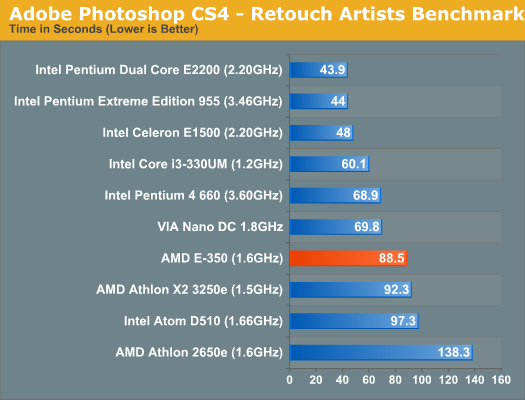
AMD's performance target for Bobcat was 90% of the performance of K8 at the same clock speed and our Photoshop CS4 benchmark shows that AMD can definitely say that it has met that goal. At 1.6GHz the E-350 manages to outperform a pair of K8s running at 1.5GHz in the Athlon X2 3250e. Unfortunately for AMD, Intel's Pentium dual-core running at 2.2GHz is much quicker. Most notebooks in the $400+ range have at least a 2.2GHz Pentium. Even the Atom D510 isn't far behind.
AMD tells me that in general purpose integer tasks, the E-350 should do well and it may even exceed AMD's 90% design target. However in higher IPC workloads, for example many floating point workloads, the E-350 is constrained by its dual issue front end. In these situations, the out of order engine is starved for instructions and much of Bobcat's advantage goes away.

Our x264 HD test has the E-350 performing within 86 - 92% of the Athlon X2 3250e, once again meeting AMD's design targets. Unfortunately, this isn't much faster than an Atom - mostly thanks to Atom's Hyper Threading support. Although not an out of order architecture, Atom gets a healthy efficiency boost by being able to execute instructions from two threads per core. Once again, compared to a 2.2GHz Pentium, the E-350 isn't close. Even VIA's dual core Nano is faster. When it comes to power consumption however, the E-350 can't be touched. I measured max system power consumption at 25.2W while running the x264 encode test. With the exception of the Atom D510, the rest of the desktop platforms here consume much more than that at idle (much less under load).
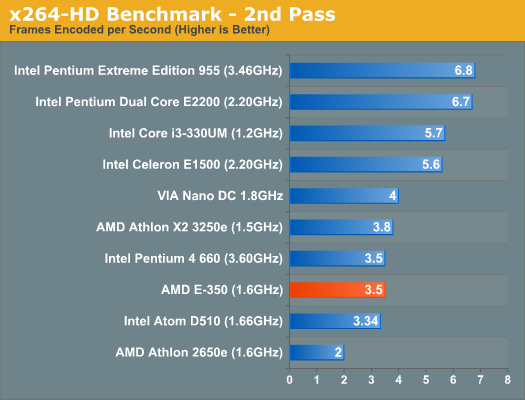
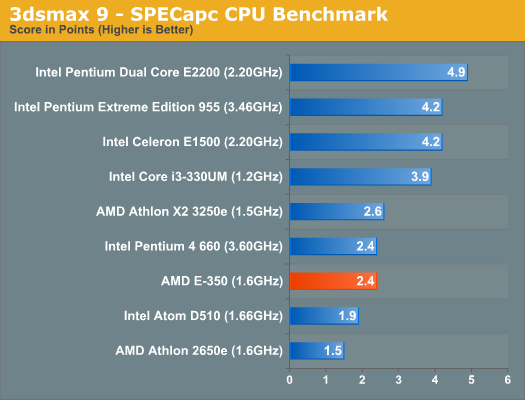
Despite being a offline 3D rendering benchmark, our 3dsmax 9 test does fall in line with expectations. The E-350 delivers 92% of the performance of the Athlon X2 3250e and outperforms the Atom D510 by 26%. Unfortunately for AMD, the Pentium dual-core holds onto a significant performance advantage here. Clock for clock, Bobcat won't be able to do much against anything Core 2 based. The real advantage here will be GPU performance.
Single Threaded Performance
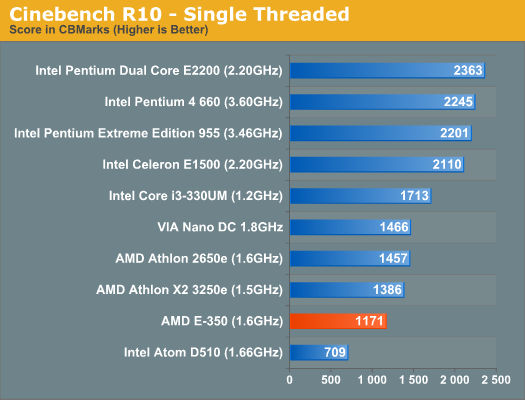
In most of our benchmarks the performance advantage over Atom isn't huge, yet using Brazos is much better than using an Atom based machine. It all boils down to one thing: single threaded performance. Atom can make up for its deficiencies by executing a lot of threads in parallel, but when you're bound by the performance of a single thread the E-350 shines. The E-350 is 65% faster than the Atom D510 in the single threaded Cinebench R10 test. It's this performance advantage that makes the E-350 feel so much quicker than Atom.
The Core i3-330UM manages a 46% performance advantage over the E-350. Even in the ultraportable Arrandale ULV space at lower clocks, AMD still leaves a lot of CPU performance on the table. The advantage here will be cost. A single E-350 is less than 40% of the die area of a Core i3-330UM. You may not get the same CPU performance, but performance per mm^2 is much higher.

In the multithreaded Cinebench test Atom is able to catch up quite a bit, but the E-350 still holds an 11% advantage.
File Compression/Archive Recovery Performance
Our final two CPU tests are both multithreaded and they show the E-350 equaling and falling behind the performance of the 1.5GHz Athlon X2. As we explained earlier, the gap between the E-350 and Atom shrinks as you add more threads to the workload.
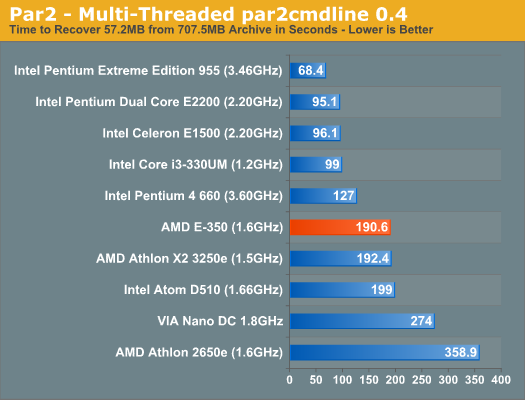
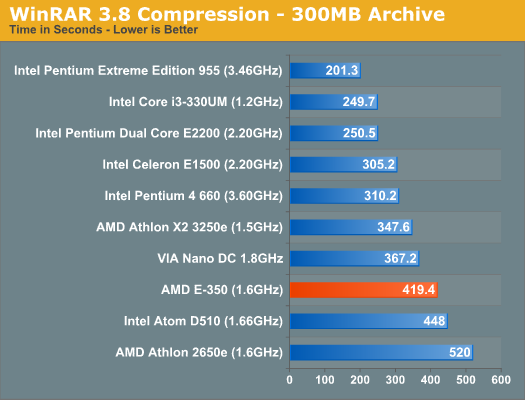










207 Comments
View All Comments
Dark_Archonis - Tuesday, November 16, 2010 - link
All of us know some Anandtech posters are AMD PR people, so no surprise here.silverblue - Wednesday, November 17, 2010 - link
Yep, and I, for example, wouldn't be running a low-end Phenom II X3 setup if I was getting fees from AMD for hyping their products (which I clearly am not, anyway).Do yourself a favour and stop spouting rubbish about conspiracies where none exist.
nitrousoxide - Tuesday, November 16, 2010 - link
OK, so Anand said that no worries about CULV Sandy Bridge series because they are more expensive, power-hungrier and bigger chips which is not a good deal for OEM manufacturers. What about the new Atom CPUs then? Intel is going to upgrade them to 32nm, which is twice as faster as today's 45nm Atoms, or half the power consumption at the same performance. Though bobcat has more efficient OoO architecture, Intel can easily improve the performance of Atom by adding more cores or tune up the frequency given the superiority of 32nm.AMD will definitely win this wave of competition, but its successor won't come until 2012. How will Fusion APUs compete with the future Atoms which will be defnitely faster then current models?
silverblue - Tuesday, November 16, 2010 - link
Yes but isn't Brazos 32nm at the very least? There's really no sense in throwing out a 3GHz dual core APU of this class because it would simply use too much power. Also, there's not much justification for any sort of Turbo clocking.What MIGHT significantly improve performance would be a dual channel memory controller (especially in the case of the GPU) but I don't know what that would mean for the die size nor the power consumption.
Let's remind ourselves of a couple of things - AMD's two thread out-of-order architecture is still beating Intel's four thread in-order architecture at the same clock speed. Brazos also has Atom completely beaten in lesser threaded workloads. Considering the primary target of these platforms isn't supposed to be massive workloads, the AMD solution will still be more capable than Intel's... for now.
silverblue - Tuesday, November 16, 2010 - link
Apparently Brazos is 40nm. When they put it onto 32nm, I imagine that anything Intel does with Atom in terms of a die shrink won't be enough to put it back in front of Brazos. We'll see.mino - Tuesday, November 16, 2010 - link
No 32nm SOI Bobcat APU will see the light of the day.There will be a Zacate/Ontario successor in H1 2012 at 28nm bulk(GloFo).
2-4 Bobcat+ cores, ~120 SP's (mostly likely 2*64 SP's of a newer design)
silverblue - Wednesday, November 17, 2010 - link
So that's where 28nm came in. You must forgive me, I lost track on that one.So yes, imagine the power drop from 40 to 28 even with a more powerful CPU. This one might even please Dark_Archonis. Might.
mino - Wednesday, November 17, 2010 - link
More like making him furious :Dmino - Tuesday, November 16, 2010 - link
"Worried about whether it can survive the next wave of attack by Intel"The funny part is that AMD's 2011 product portfolio is as strong as it has not been for the past 15yrs.
It is AMD attacking this time around gals. Just think about it for a minute ... 1999 ... 2003 ... 2011 ...
Lolimaster - Tuesday, November 16, 2010 - link
Q4 2011/Q1 2012 TSMC will deliver the next low power Fusion at 28nm.Krishna & Wichita with 2 and 4 cores flavors (real ones).
Anandtech an Inteltech site? We all know that, just leave with it.